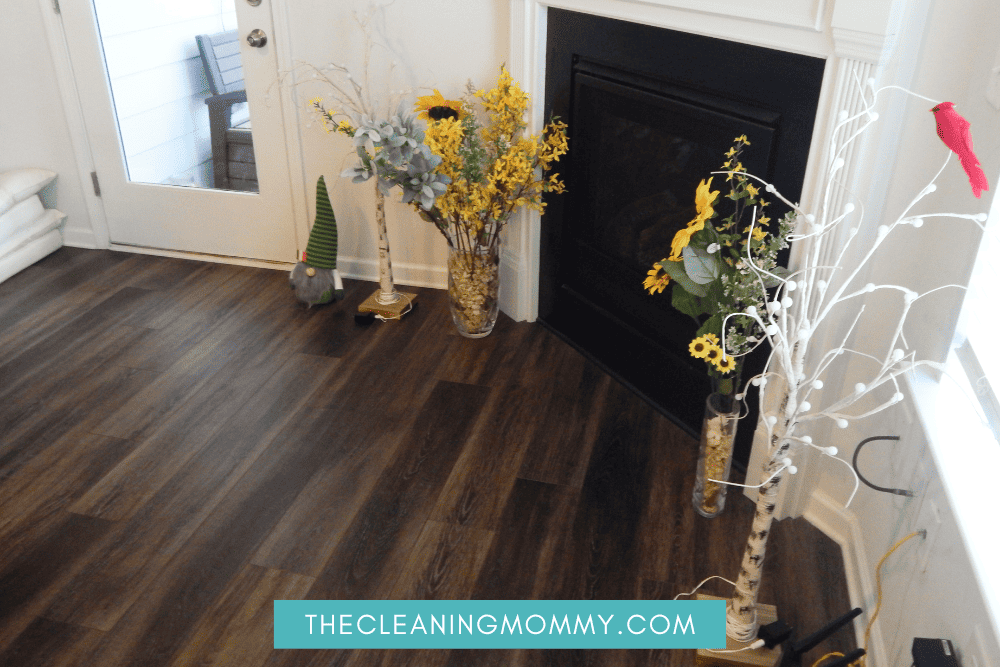Have you ever stared at a stubborn stain on your linoleum floor, wondering if bleach is the answer? It’s a common question, especially when dealing with spills or grime that seem impossible to remove. But before you reach for the bleach, it’s essential to understand the potential risks and implications of using this powerful cleaner on your floors.

Image: thecleaningmommy.com
Linoleum is a durable and versatile flooring material, often found in kitchens, bathrooms, and entryways. It’s known for its resistance to water and wear, but even this resilient material requires careful upkeep to maintain its beauty and longevity. So, let’s delve into the world of linoleum cleaning, focusing on bleach and its role in keeping your floors sparkling.
The Dilemma: Bleach and Linoleum Floors
The desire to bleach linoleum stems from its reputation as a potent disinfectant and stain remover. However, bleach is a harsh chemical, and using it indiscriminately can lead to:
- Damage to the linoleum surface: Bleach can strip away the protective top layer of linoleum, leaving it dull, brittle, and susceptible to scratches and discoloration.
- Color fading: Linoleum often comes in various colors and patterns. Bleaching can cause these colors to fade, leaving an uneven and unattractive finish.
- Harmful fumes: Bleach releases strong fumes that can irritate the eyes, nose, and throat, especially in enclosed spaces.
- Potential reactions: Mixing bleach with other cleaning products can create hazardous fumes and even cause explosions.
While the allure of bleach’s cleaning power might be tempting, it’s crucial to navigate the process with caution.
Alternatives to Bleach for Linoleum Cleaning
Fortunately, several gentler and safer alternatives can effectively clean and disinfect your linoleum floors without compromising their integrity:
- Baking soda: A non-toxic and abrasive powder that effectively lifts grime and stains. Mix baking soda with water to create a paste, and apply it to the affected area. Let it sit for a few minutes before scrubbing gently.
- Vinegar: A natural disinfectant and deodorizer, vinegar effectively cleans greasy stains and removes built-up soap scum. Mix a solution of equal parts vinegar and water, and apply it to the floor with a mop or cloth.
- Dish soap: A mild and effective cleaner that can be used for everyday cleaning. Add a few drops of dish soap to a bucket of warm water, and mop the floor.
- Specialized linoleum cleaners: Many commercial linoleum cleaning products are specifically formulated for this type of flooring. They effectively remove dirt and grime while leaving a protective finish.
When (and How) to Use Bleach on Linoleum Floors
There are rare instances when using bleach on linoleum might be necessary. For example:
- Severe mold or mildew infestation: If your linoleum floor has a persistent mold or mildew problem, a diluted bleach solution might be necessary to eliminate these microorganisms.
- Bleach-safe linoleum: Some specialized linoleum varieties are treated with a protective coating that is bleach-resistant. Always consult the manufacturer’s instructions before using bleach on these types of floors.
If you choose to use bleach on linoleum, always follow these safety precautions:
- Dilute properly: Never use bleach straight from the bottle. Always dilute it with water according to the manufacturer’s instructions.
- Test on an inconspicuous area: Before applying bleach to the entire floor, test it on a small, hidden section to ensure it doesn’t cause any discoloration or damage.
- Ventilate the area: Open windows and doors to ensure proper ventilation while using bleach.
- Wear protective gear: Wear gloves, eye protection, and a mask to avoid direct contact with bleach.
- Rinse thoroughly: After cleaning, rinse the floor thoroughly with clean water to remove any bleach residue.

Image: mromavolley.com
Maintaining Your Linoleum Floor’s Beauty
Just as important as cleaning is proper care:
- Regular sweeping and mopping: Regular maintenance, including sweeping daily and mopping weekly, can prevent dirt and grime from building up.
- Spot cleaning spills immediately: Addressing spills promptly prevents stains from setting in.
- Using a protective finish: Applying a high-quality linoleum floor polish regularly can help protect against scratches, stains, and discoloration.
Expert Insights: From Professional Cleaners
Here’s what professionals in the cleaning industry recommend:
- “Avoid bleach on linoleum as a general rule. There are safer and more effective cleaning methods available.” – Sarah, Professional Home Cleaner
- “If you must use bleach, always dilute it significantly and apply it sparingly. Rinse thoroughly afterwards. ” – Jack, Cleaning Service Owner
Can I Use Bleach On Linoleum Floor
The Bottom Line: Choose Wisely
Linoleum floors, with proper care, can last for years. While bleach might offer a tempting cleaning solution, choosing gentler methods will ultimately protect the beauty and longevity of your floors. Remember, an ounce of prevention is worth a pound of cure! Start with regular cleaning and maintenance, and if you need to address a persistent stain, look to alternatives before reaching for bleach.






